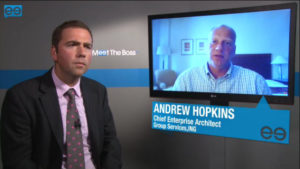

Enterprise Content Management: Become a Value Creator
When discussing business solutions, you could often be forgiven for thinking you’ve just walked into a spelling bee. BPO. OSS. CRM. Sorry, could you put that in a sentence please?
-Of course, it’s unavoidable in today’s tech-heavy world of enterprise solutions; without them, we’d spend our days in a binary mantra of repetition, hopelessly spinning the hamster wheel of vocabulary. So while we hold our hands up to eventually joining the AA (Acronyms Anonymous) there’s one that we’ve been keeping our eye on recently, and with very good reason: it’s pivotal to the future of many an enterprise.
Whether you’re talking about inducing better customer service or internal streamlining, Enterprise Content Management (ECM) has shot onto the radar in recent months as our virtual worlds continue to impact – and hopefully relieve – our previously cluttered (and retrospectively rudimentary) offline processes.
Over on MeetTheBoss TV this week, Adam talked with Andrew Hopkins, Chief Architect of Group Services at ING Group, about how ECM is helping to differentiate the financial services giant with quick, effective access to relevant data across the group in a global context.
His answer?
Use ECM To Become a Value Creator
“We’re treating the ECM solutions, the data and the information behind it as part of a big data strategy,” explains Hopkins. “We’re trying to leverage that data; implement that information internally to make our channel easier and more effective for the customer to use. We want to allow the customers inside our firewall, so they can actually see, manage and control the information we hold on them to their own benefit, but also to allow us to better serve them as well.”

To do this, Hopkins explains how they first stabilised their environment, before looking at how to add value to the business. The key here, as Hopkins puts it, is to find a way of “…becoming more business orientated IT rather than IT just driving IT for its own sake.”
You might be thinking at this point, ‘that’s all well and good, but I’m not a global financial services group, nor am I looking to build a peep-hole in my ECM solutions for customers – so what does that mean to me?’
Well, more than you’d think. When it comes to the crunch, every enterprise needs to answer the same questions at some point: How do we start adding value to the business? How do we start becoming more customer centric? How do we start engaging? At some point, an answer is inevitably going to touch upon what to do with the years of content that have built up prior to having an automated ECM. Moreover, how can you align your various offices to ensure your ECM rollout is a success? Fear not. If you’re asking these questions, you’re on the right track.
Governance: Write Your Own Rule Book
Hopkins refers a “backpack of legacy” that talks of bringing ING’s 30-40 years worth of historical data into the ECM mix, or as Hopkins describes: “…trying to bring in the new world and retain the old world, and at least running it down and starting to decommission it is a big challenge.”
As far as this “new world” is concerned, cloud services – and the cloud collaboration technologies that are sure to follow – will play a pivotal role with ECM systems. Why? Because as ECM continues to evolve for enterprises across the globe, controlling that content – and the subsequent cloud services holding such content – will start to dictate that ECM’s ceiling of success.
For Hopkins and all at ING, this means writing a rulebook for CIOs, COOs and CEOs in each of INGs regions. “The critical component to us at the moment is the decision we made about implementing the technology in a replicated fashion. The key is finding out how we keep control over that,” explains Hopkins.
“How do I make sure that when we’re replicating the solution from the Netherlands to Spain, or from Spain to Turkey, that replicated version of the solution is not then customised by the location itself to such a degree that it becomes a real headache – not just in lifecycle terms, but in retrieving information and embedding it within our business process. The governance across all of these replicated instances is probably one of the biggest challenges we have.”
In watching Hopkins’ interview with Adam, one thing was explicitly clear: A successful ECM implementation will only prevail if you can first define how you want your information to work for you, then aligning your processes and technologies accordingly to induce change.
Without either of these in place, you’ll soon find yourself in a world of retrofitting and legacy issues – and, I’m sure, find a few new acronyms to describe the feeling.